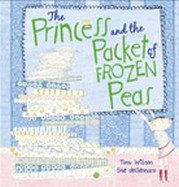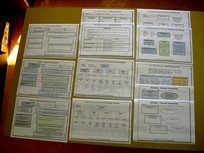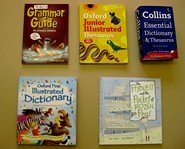Language Therapy Narrative
 Language Therapy Narrative: This webpage demonstrates a typical language intervention
session with an 11 year old girl with language impairment.
Language Therapy Narrative: This webpage demonstrates a typical language intervention
session with an 11 year old girl with language impairment.
The language skills the clinician
has targeted are
narrative skills,
or another term we could use, story grammar.
The goal of these particular language therapy webpages is to demonstrate real, authentic language
intervention techniques and provide you with strategies and examples of high efficacy language therapy.
The goal is for you - whether you be a speech-language pathologist, teacher or parent - to have confidence to try this type of language intervention on your own students.
The language intervention method chosen is based on communicative reading strategies (Norris, 1991), as outlined and explained in Kathryn DeKemel's book,
Intervention in Language Arts.
Another book worth reading about text-based
intervention is Geraldine Wallach's ,
Language Intervention for School-Age Students.
To acquaint yourself with communicative reading strategies as a language intervention method, I recommend you
access the
Shared Book reading
page and associated links. This will give you a brief but thorough background and foundation in the theory of communicative reading strategies.
Available for download, on the
Shared Book Reading
page, is information and examples of communicative reading strategies being used as language intervention. Please download those pages and read, print and have them in front of you, because I may occaisonly refer to the techniques outlined there on this page.
Background Information
Language Therapy Narrative cont...
Let's begin...
Background Information: Simone (name and situation changed) is an 11 year old girl who has a history of
poor literacy skills. Simone's class teacher described her reading and reading comprehension skills as weak.
An oral language assessment (CASL - Comprehensive Assessment of Spoken Language, 1999, Elizabeth Carrow-Woolfolk)
revealed that Simone's receptive and expressive language skills were well
below average. A spelling test (Dalwood Spelling Test) indicated that Simone's spelling skills were
moderately below average.
Simone read an appropriate grade level book to the clinician and any miscues were
noted. A narrative analysis revealed that Simone had poor recall of story details, and poor comprehension.
Simone's decoding skills were reasonably good in that she made few miscues while reading the text.
Narrative and Story Grammar Language Goals
Language Therapy Narrative cont...
Objective: Simone will identify story grammar and narrative concepts from an authentic children's
storybook.
Learning Approach: Communicative reading strategies, language stimulation techniques and story grammar principles.
Materials: Storybooks, reference books, graphic organizers.
Rating System: Narrative Scoring Chart
Resource Download
 Therapy Goals Worksheet
Therapy Goals Worksheet
Right-click to download this PDF file here.
Book Selection
Language Therapy Narrative cont...
Selecting the right book for language intervention is an important process. It's critical that the book chosen for therapy is at the right level of complexity for the student. If the book's too
difficult to understand the child may flounder; if the book's too easy, the student will learn very little.
The
Fry readability graph
is a useful tool for selecting books, based on grade level. But, perhaps the most
important method of book selection is to have your student read to you from a book from their grade level and
note the number of miscues.
Then ask the student a series of comprehension questions to determine how
well they understood the story and its themes.
Selected Book
Language Therapy Narrative cont...
 The Princess and the Packet of Frozen Peas,
by Tony Wilson, Illustrated by Sue DeGennaro, 2009.
The Princess and the Packet of Frozen Peas,
by Tony Wilson, Illustrated by Sue DeGennaro, 2009.
The Princess and the Packet of Frozen Peas
Author: Tony Wilson
Illustrator: Sue DeGennaro
Published by Scholastic Australia, 2009
ISBN 9781741693362
Fry Readability Graph rating: Grade 5 level text.
A reading miscue analysis indicated that Simone could read the text adequately, but had difficulty comprehending the meaning of the text and its themes.
The Princess and the Packet of Frozen Peas
was selected as the primary language intervention text because the story had all the necessary
elements of narrative and story grammar.
Other Therapy Materials
Language Therapy Narrative cont...
 Graphic Organizers: key information expanding worksheets. The worksheets pictured here are
all available as adobe downloads on this page.
Graphic Organizers: key information expanding worksheets. The worksheets pictured here are
all available as adobe downloads on this page.
The graphic organizers are designed to improve your students' understanding of story grammar
concepts by providing a visual outline of the main elements of a story.
 Dictionary and Thesaurus: New or difficult words, and their definitions, are explored in a dictionary, while synonyms, for newly learnt words, are probed via a thesaurus.
Dictionary and Thesaurus: New or difficult words, and their definitions, are explored in a dictionary, while synonyms, for newly learnt words, are probed via a thesaurus.
The use of a dictionary and thesaurus is an important aspect of communicative reading strategies.
Story Synopsis
Language Therapy Narrative cont...
The Princess and the Packet of Frozen Peas is a satire of the well know Hans Christian Anderson story, the Princess and the Pea. The main character, Prince Henrik, wants to fall in love and get married to one of the local girls, but he's not sure how to do it.
So Henrik asks his brother for advice. His brother married Princess Eva, who's a beautiful but sensitive girl
who complains and moans about everything. Prince Henrik decides he doesn't want a sensitive girl, but someone
who likes what he likes, and has a nice smile.
Prince Henrik creates a series of tests to find the right girl. This includes each of the prospective princesses
having to sleep on a thin camping mattress, in an old sleeping bag, on top of a packet of frozen peas.
Many of the sensitive girls fail the test, all except Pippa, an old friend of Henrik's. Pippa likes the same things Henrik likes and doesn't mind at all that she has to sleep in an old sleeping bag on top of a packet
of frozen peas. She also has a nice smile.
Prince Henrik decides to marry Pippa. Pippa protests that
she's not a real Princess, but Henrik tells her she'll be an UNREAL PRINCESS.
Language Intervention Session
Language Therapy Narrative cont...
Story maps are the core language teaching tool for this particular session. A story map is an excellent visual aid in that it provides a graphic representation of the elements of
a story.
Many fictional stories are constructed using the elements of story grammar, (DeKemel, 2003). That is,
fictional stories have a main character; they have a setting, an initiating event, a problem, a plan and actions. Most stories also have a resolution in that the main character learns a valuable lesson.
The Story is Read Together
Language Therapy Narrative cont...
The session begins by both the clinician and Simone reading the text together - shared reading. Simone reads
a particular passage and then the clinician reads a passage, and so on.
The entire text is completed by both readers in 12 minutes. The emphasis at this point is on completing the story, not focusing on specific
language embedded in the text.
Clinician: 'What a good story. I enjoyed that. How did you find the story Simone? Did you like it?'
Simone: 'It was alright'
Clinician: 'I like how the author changed the original story into something new. He's made it into kind of like a modern fairy tale. Very clever. What did you think of Princess Eva?'
Simone: 'She wasn't very nice. She complained a lot about stuff.'
Clinician: 'Yes, she was very sensitive wasn't she. We might come back to what that word may mean later, but what I'd like us
to do now is have a look at these story maps.'
The word sensitive and its implied meaning in the context of the story would be an excellent topic to explore using
communicative reading techniques. But perhaps another time. It's important to stick with the original goal of the session: to identify
and explore narrative and story grammar elements.
Graphic Organizers - Story Maps
Language Therapy Narrative cont...
The graphic organizer narrative worksheet is placed in front of Simone.
Clinician: 'This is called a graphic organizer, a story map. It allows us to look at how the story was constructed. It's kind of like looking beneath the surface of the story to see how it was all put together.'
Resource Download
 Narrative Worksheet - Story Map
Narrative Worksheet - Story Map
Right-click to download this PDF file here.
 Narrative Worksheet - Story Map (Example)
Narrative Worksheet - Story Map (Example)
Right-click to download this PDF file here.
 Narrative Worksheet - Story Map (Theory)
Narrative Worksheet - Story Map (Theory)
Right-click to download this PDF file here.
Story Title and Setting
Language Therapy Narrative cont...
Clinician: 'At the top of the page it says Story Title. Write the title of the story in there
please.'
Simone writes in the Story Title Box. A secondary goal of this session is for Simone to work on her writing and
spelling skills. Simone makes a couple of spelling errors copying the title from the book. She is made aware
of her errors by the clinician and she corrects them.
Clinician: 'You'll notice Simone that the first box directly beneath the Story Title box is titled setting.
Do you have any idea what setting may refer to?'
Simone: 'Um, does it mean, like, where the story is?'
Clinician: 'Yeah, that's pretty close. The setting is where and when the story takes place. The Princess and the Packet of Frozen Peas is based on a fairy tale written over 100 years ago. The story
was called the Princess and the Pea. Have you ever heard of it?'
Simone: 'I think so. I've heard it before.'
Clinician: 'Well, that story was set in medieval times, which means a very long time ago. It was a time when there
was no electricity, no cars, no washing machines. Is our story, the Princess and the Packet of Frozen Peas, set in that time?'
Simone: 'I think so.'
Clinician: 'Really? Go through the book and have a look at the pictures. There are a number of fairly modern things
in there.'
Simone leafs through the book and finds a number of modern items: a car, a washing machine, a telephone
and a modern looking oven.
Clincian: 'I think we'd be right in saying that this story is set in modern times. It may be based on a very old
story, but the original story of the Princess and the Pea can certainly be transplanted into a modern setting.'
Some of the language the clinician used above may be a little too abstract for Simone. It may be worth exploring themes
such as transplant, old versus modern, and original versus new. But not today. The clincian makes a note of these themes as something
to be explored later with Simone.
That's the thing with communicative reading strategies. Great ideas for language
intervention 'pop up' all the time while working on a text, but can't always be indulged in at that time. Again, it's important to stick to the main goals.
Clinician: 'We know when the story is set. It's set in modern,
or, current time. But where is it set?
Simone: 'I think it says something about being set in a palace.'
Clinician: 'That's right. The story's set in a palace. Well done Simone. You've obviously been paying attention.'
Story Start - Initiating Event
Language Therapy Narrative cont...
Clinician: 'Simone, read out the sub-heading in the Story Start box.'
Simone reads the sub-heading which asks the question, 'What sets the story in motion?'
Clinician: 'Something happens at the very beginning of the story. A problem that Prince Henrik has.
Read the first page again. What problem does Henrik have at the start?'
Simone reads the first page.
Simone: 'It says, he wanted to fall in love and get married.'
Clinician: 'Yes, he wants to get married, but he doesn't have a girlfriend or much clue about how to marry someone. So write into that box that Henrik wanted...' (Cloze Procedure)
Simone: '...to get married. But he didn't know how to do that.'
Simone writes, in her own hand, that Henrik wanted to get married but didn't know how, into the Story Start box.
Character's Internal Response and Plan
Language Therapy Narrative cont...
Clinician: 'So, how does Henrik feel at the start of the story Simone?'
Simone scans the first couple of pages.
Simone: 'I don't know. It doesn't say'
Clinician: 'No it doesn't, so we may have to infer how he feels. We know he doesn't have a girlfriend but
wants to get married. So we can infer that, perhaps, he may be a little lonely. But he also
knows what he wants. What does it say he likes to do?'
Simone: 'He likes to door outdoors stuff. Hockey and camping.'
Clinician: 'So, Henrik is looking for a princess who likes what he likes - outdoor activities.
What does Henrik plan to do?'
Simone: 'Get married?'
Clinician: 'Yes, certainly, he plans to get married. He wants to get married,
so he needs to find the right girl. What does Henrik do first to find the right girl?'
Simone scans through the first few pages of the book.
Simone: 'He asks his brother for advice.'
Clinician: 'That's right, he asks his brother what he should do to find the right sort of princess.'
Simone is instructed to fill in the the two boxes titled Internal Response and Plan, which relates to how
the character feels about the problem and what he intends to do about it.
Attempts - What the Character Does About the Problem
Language Therapy Narrative cont...
Clinician: 'We now know that Henrik is looking for a princess to marry. He does a number of things to find the right girl.
You've identified that Henrik asks his brother, Prince Hans, for advice. His brother has married Eva, who complains a lot
and isn't very nice to people.'
Simone: 'Yeah, she's really bad.'
Clinician: 'So, Prince Henrik decides to do something about it. He doesn't want anyone like Princess Eva.
He makes a decision and comes up with a plan. What does Henrik plan to do?'
Simone scans the book and finds the pages which describe Henrik's plan to have girls stay at the palace and offer
them the guest room. The girls have to sleep on a thin camping mattress, in an old sleeping bag, on top of
a packet of frozen peas.
Simone: 'It says he tests the girls by making them sleep on a thin mattress. And they had to sleep in a sleeping bag.'
Clinician: 'Where were the peas?'
Simone: 'Under the mattress, so it would have been really lumpy.'
Simone is encouraged to write about Henrik's plan into the box labelled Attempts.
Consequences
Language Therapy Narrative cont...
Clinician: 'The consequence of Henrik's actions is that he filters out and rejects the girls
who complain about the packet of frozen peas. All except Pippa.'
'So we could say that as a consequence of
Henrik's plan and action he works out that he doesn't want a sensitive princess, he wants an outdoorsey
girl who like the same things he likes.' (Paraphrase)
The clinician encourages Simone to write in the
consequences box the outcome of Henrik's attempts to find
the right girl.
Simone: 'What do I write?'
Clinician: 'Well, what did Henrik do to find the right girl?'
Simone: 'He wanted the girls to sleep on the packet of peas, and they didn't like it and said "yuck."
Clinician: 'That's right. And he then found that he actually really liked his old friend...' (Cloze Procedure)
Simone: 'Pippa.'
Clinician: 'So, write all that in. Use your own words.'
Simone writes the outcome of Henrik's plan into the consequences box. The clinician helps to guide her written responses
and checks to make certain she has the main ideas down.
Resolution
Language Therapy Narrative cont...
Clinician: 'The resolution is really about what happens at the end of the story. Does Prince Henrik find
himself a princess to marry?'
Simone: 'Yes, he wants to marry Pippa.'
Clinician: 'How does Prince Henrik feel about finding Pippa?'
This question requires Simone to infer Prince Henrik's feelings. There is nothing stated in the text to
suggest that Henrik is overjoyed or deliriously happy, but we can infer that he is.
Simone: 'He's happy.'
Clinician: 'How do we know Prince Henrik is happy?'
Simone sits in silence. The clinician asks Simone to re-examine the last few pages, and she is encouraged to find little hints or clues about how important it was to Henrik that Pippa passed the test.
Clinician: 'On this page it shows Henrik as he waits for Pippa to wake up. It says he waited...and waited...and waited.
His face changes expression too. He starts off feeling happy, and progresses to actually look quite anxious and worried. So we can infer that Henrik really wanted Pippa to pass the test.'
'If Pippa had
turned out like the other girls, who complained a lot, we can imagine that Henrik would have been very sad and disappointed. But Pippa didn't fail the test. She passed. So the outcome of the story is that Henrik...'(Cloze Procedure)
Simone: 'Henrik married Pippa because he thought she would be an unreal princess. And they would be happy together, I think.'
Clinician: 'Well done Simone. Now write what you said in the resolution box at the bottom there.'
Narrative Intervention - Summarization
Language Therapy Narrative cont...
The clinician finishes the session by summarizing the key points and reviewing the
story grammar terms learnt by Simone.
Clinician: 'We learnt an enormous amount about how stories are constructed today Simone. Thank you for working so hard. We learnt about the story title and the setting. We know that the main character usually
has a problem to overcome. In this story, Prince Henrik wanted to find the right girl to marry.'
'We also learnt that the character has an internal response and feels a certain way about the problem and plans to
overcome the problem. In our story Prince Henrik decides he doesn't want a sensitive princess and sets up
a series of tests to find the right girl to marry.'
'We spent some time working out what the characters attempts were and what the consequences were. And we
talked about the resolution, the ending of the story and how the character felt at the end of the story.'
Narrative Intervention - Conclusion and Scoring Chart
Language Therapy Narrative cont...
Resource Download
 Narrative Scoring Chart
Right-click to download this PDF file here
Narrative Scoring Chart
Right-click to download this PDF file here.
The above language intervention session is an accurate portrayal of a typical text-based language therapy session.
The exchange between the clinician and Simone went for 40 minutes. During the session Simone was required to
think about language and story structure (
metalinguistic awareness
tasks) in new ways.
Simone learnt
most of the main story grammar elements in one session. However, it's
unlikely that Simone learnt all the terms perfectly or understood all elements at a high level.
Before the session began, the clinician wrote down some comprehension questions related to
The Princess and the Packet of Frozen Peas on the
Narrative Scoring Chart.
At the
end of the session, Simone was asked the
literal and
inference questions that were penned prior to the session. Simone's responses indicated that she had a
reasonable understanding of
the story structure and motivation of the character.
However, the clinician concluded that Simone would benefit
by repeated teaching of story grammar elements in future language therapy sessions.
Narrative Intervention - Next Session
Language Therapy Narrative cont...
The next session would consistent of these goals:
Goal 1: Revise
story grammar elements.
Goal 2: Introduce
Character map and
Character Traits map.
Goal 3: Introduce
Setting story map.
References
Collins Essential Dictionary and Thesaurus (2007) Harper Collind Publishers
DeKemel, K.P. (2003) Intervention in Language Arts: A Practical Guide for Speech-Language Pathologists. Butterworth-Heinemann.
Kaderavek, J & Justice, L.M. (2002) Shared Storybook Reading as an Intervention Context: Practices and Potential Pitfalls. American Journal of Speech-Language Pathology, Vol 11. 395-406.
Norris, J.A. (1991) From Frog to Prince: Using Written Language as a Context for Language Learning, Topics in Language Disorders. Vol 12, 66-81
Paul, R. (2001) Language Disoders form Infancy through Adolescence. Assessment and Intervention. Mosby
Wallach, G.P. (2008) Language Intervention for School-Age Students: Setting Goals for Academic Success. Mosby Elsevier
Wagner, R.K. Muse, A.E. & Tannenbaum, K.R. (2007) Vocabulary Acquisition: Implication s for Reading Comprehension. The Guilford Press
Wilson, T. & DeGennaro, S. (2009) The Princess and the Packet of Frozen Peas. Scholastic, Australia
Content Last Modified 8/11
Return from Language Therapy Narrative to Language Therapy
Enjoy this page? Please pay it forward. Here's how...
Would you prefer to share this page with others by linking to it?
- Click on the HTML link code below.
- Copy and paste it, adding a note of your own, into your blog, a Web page, forums, a blog comment,
your Facebook account, or anywhere that someone would find this page valuable.



 Language Therapy Narrative: This webpage demonstrates a typical language intervention
session with an 11 year old girl with language impairment.
Language Therapy Narrative: This webpage demonstrates a typical language intervention
session with an 11 year old girl with language impairment.

 Graphic Organizers: key information expanding worksheets. The worksheets pictured here are
all available as adobe downloads on this page.
Graphic Organizers: key information expanding worksheets. The worksheets pictured here are
all available as adobe downloads on this page.
 Dictionary and Thesaurus: New or difficult words, and their definitions, are explored in a dictionary, while synonyms, for newly learnt words, are probed via a thesaurus.
Dictionary and Thesaurus: New or difficult words, and their definitions, are explored in a dictionary, while synonyms, for newly learnt words, are probed via a thesaurus.
